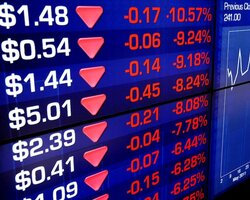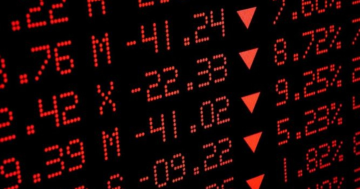Kelly Simpson* shares her top five tips for long-term investors.
 It’s pretty easy to find bad news at the moment.
It’s pretty easy to find bad news at the moment.
There’s war, inflation, a pandemic, supply chain constraints, a market correction, talk of a recession, rising interest rates, a rental crisis, cost of living pressures – and nobody knows what’s going to happen next.
Zombie outbreak? Wouldn’t surprise us.
Theoretically, as a long-term investor, you know to expect the ups and downs of the market.
You know that global markets are the aggregate of underlying businesses and productivity, which tend to get bigger and more efficient over the longer term, generally leading to growth.
You know that investing in this growth can lead to wealth – it’s probably one of the reasons why you do it.
And if you’re a long-term investor – as we are at Spaceship – you’re not trying to time the market, which has proven to be impossible.
But in real life? The sky is falling.
Your portfolio’s tanking.
You feel like you’ve been conned, and it feels terrible.
So what should you do during a market downturn?
- Think about your investing horizon
Generally, when we talk about ‘long-term investing’, we talk about time periods of at least seven years.
That’s because it’s pretty much guaranteed that no matter what you’re invested in, there will be time periods when your portfolio declines in value.
The more time you have, the better chance you have to ride it out.
Market volatility is a feature of investing and not a bug.
History shows that in most years, the S&P 500 falls by an average 14 per cent before it ends positive.
This isn’t to say that you’ll make money every year – just that, on average, it’s more likely than not.
If you believe in your investment, it could pay to keep investing through the highs and lows for the time period you initially intended.
- Double down on your research
In a downturn, it can pay to make sure you’ve done as much research as you can on your investments, so you’re as confident as you can be in their long-term futures.
This extra confidence could help you stomach a market drop.
At Spaceship we look at four key criteria before deciding to take a long-term position in a company by adding it to our Spaceship Universe or Spaceship Earth portfolios.
These four criteria include:
- strong management;
- evidence of adhering to a long-term, secular trend (such as cloud computing or digital payments);
- having a moat, which is a competitive advantage that may include a strong brand;
- and having the potential to double in company size within five years.
We call this criteria Where the World Is Going.
The Investment team asks questions like, “What makes this company unique?” “Why should we own it?” “Why might we be wrong?”
The team researches elements such as competition, trend growth, company history, and they meet with management where possible to make sure they’re investing your money as responsibly as they can.
They keep tabs on industries, look at key financial metrics, conduct ESG analyses for companies that are contenders for the Spaceship Earth portfolio, and – to make sure they’re researching as broadly as they can – they figure out what the ‘bear’ case is for each company, that is, the reasons why it might fail.
Generally, they’ll only look to remove companies from our portfolios if one of the four criteria changes – and not due to short-term volatility.
Generally, when we talk about short-term investing, we mean anything shorter than a period of about three years.
If the team were chopping and changing depending on the ups and downs of the market, they would be short-term investors operating under a different thesis.
They’d be investing where the world has been, not where it’s going.
- Remember you can dollar-cost average both into and out of positions
To get the full benefits of dollar-cost averaging, which is investing regularly to reduce the chance of buying an asset at its high, you generally have to stay in the game.
Otherwise, you’ll be missing the potential to profit off an asset’s recovery.
Essentially this would mean that your average price of a stock or unit is higher than it could have been, as there’d be less growth upon recovery.
On the other hand, if you’ve decided you feel more comfortable selling your investment, you could use the same method to reduce the risk of selling your whole investment at a low, by selling regular similarly sized parcels over time instead.
In this way you could use the dollar-cost averaging method to sell your investment and reduce the risk of selling at the bottom.
Just keep in mind that nobody knows when the market is going to turn, and dollar-cost selling in a falling market may keep reducing your returns over time, if you finish selling before the market stops falling.
- Are you being fearful, or greedy?
Stock markets are made up of people who make decisions about whether to buy or sell different assets, based on such criteria as their individual risk profiles, time horizon, conviction, and market conditions.
It’s been said that the markets operate in two modes: fear and greed.
You may have heard Warren Buffet’s famous quote to be “fearful when others are greedy, and greedy when others are fearful.”
His belief is that fearful markets drive asset prices lower, and greedier markets drive asset prices higher than they should fairly be.
CNN tracks seven market indicators in its Fear & Greed Index to plot the ‘mood’ of the US market as a whole.
As the world’s biggest market, it can be a pretty good indicator of what’s happening globally.
The intention of the Fear & Greed Index is to give investors a tool to remember that they’re emotional humans who can act irrationally in the face of volatile market conditions – whether their portfolios are red or green.
It’s an interesting depiction of how the overall market could be feeling, particularly if you’re feeling the same.
- Don’t panic
If you panic sell your investments and lock in your loss, you’ll both lose money and be less likely to invest again in the future.
It’s the flipside to FOMO, where you panic buy a rising asset because you think it will keep climbing and there’s easy money to be made.
When you’re deciding whether to keep buying, holding, or to sell your investment, make sure you’re doing so with respect to the reason why you invested in the first place.
If you still believe in the underlying thesis of the investment, it could be worth sticking it out.
If you think you’re better off selling, consider researching the most effective way to make sure you’re not locking your loss in at what might be its lows.
*Kelly Simpson is a Content Marketing Lead at Spaceship based in Sydney, New South Wales.
This article first appeared at spaceship.com.au.











